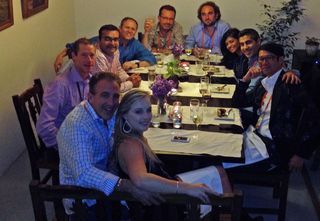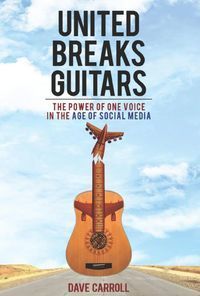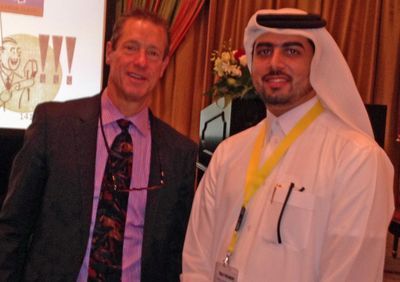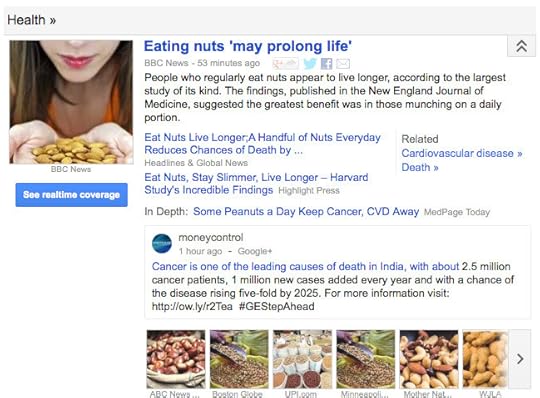David Meerman Scott's Blog, page 69
December 30, 2013
Adding context to content to create sales magic
I recently had an excellent conversation with my friend Greg Alexander, CEO of Sales Benchmark Index, about how marketing and sales can work together more effectively.
I spent most of my career in business-to-business marketing, although for four years I was in B2B sales. So I've seen both sides.
Back in the mid-1990's it was hard to find evidence of love between marketing and sales. At many B2B companies the relationship was downright adversarial. Often, the tension extends all the way up to senior management.
It all stemmed from the sales process involving a "handoff." Marketing generated leads, handed them over to sales, and then the sales team owned them until close.
So Greg and I chatted about how sales and marketing work effectively together. We discussed the new buying process and what that means for salespeople, marketers, and their management teams.
In my simplistic first stab at this, I offered that marketing must create the content that salespeople need to be successful in the selling process. It could be in some repository somewhere where salespeople could access it or it could be free on the web. But the salesperson knows how to get it where it’s located.
This means that what the marketing team does is important for the entire sales process, not just for the top of the funnel as was true just a few years ago, because salespeople are using content all the way to closing the deal.
It is, I said, the salesperson’s job is to understand each individual buyer or existing customer so well that they know precisely which bits of content should be pointed to them.
Adding context to generate magic
But Greg took it much further.
“What the salesperson has to do is implement context,” Greg said. “This is where contextual content marketing actually happens. The marketing department is doing everything you just said, which is huge because salespeople don’t have the time to do all that. And sometimes they don’t have the skills.”
In Greg’s view, the salesperson, as the expert in the customer, takes what the marketing department creates and then personalizes it for each buyer or existing customer and passes it on in whatever method is best: LinkedIn, Twitter, email, or even the good old telephone. It is a reason to make contact.
“Sales reps take the information and say: 'How does this idea, this theme, this concept apply to my account and my decision-makers inside those accounts?',” Greg says. “'How do I make this real them? How do I provide context for it?' That’s where the magic happens.”
Are you making magic?
December 25, 2013
The best and worst of 2013 holiday marketing
This holiday season, many thousands of companies did what is expected – interrupt us with inane greetings. Marketers spend time and money because, well, “aren't we supposed to send greetings to clients?”
The vast majority I received were a complete waste of time. Do you really want to open an email from, say, your credit card company wishing you a happy holiday? Or worse, how about those printed messages sent in the mail. Most just contribute to trash (or recycling) heaps.
In the holiday spirit, I’m refraining from calling out offenders by sharing any “worst” examples. You know who you are.
WestJet Christmas Miracle: real-time giving
The best marketing I’ve seen is the terrific WestJet Christmas Miracle: real-time giving YouTube video. If you haven’t seen it, do yourself a favor and spend a few minutes now.
Westjet nailed this one (and as a result have generated 33 million views as of this writing).
The concept is unique and highly creative. It is, of course, real-time. And it is audacious! Could you imagine getting the bosses at your company to agree to an effort like this?
Awesomeness
Thank you Westjet for brightening my day with your video.
Knowing that I love real-time marketing, several people sent me a link to the video. The first was Jeff Humphreys. Thank you for sharing.
December 23, 2013
How to generate sales with social media in an underground business
 Many people I meet have a tough time using content for sales and marketing purposes. This is especially true for those who have spent their entire career generating attention via paid advertising, traditional media relations, and direct sales efforts.
Many people I meet have a tough time using content for sales and marketing purposes. This is especially true for those who have spent their entire career generating attention via paid advertising, traditional media relations, and direct sales efforts.
With that context in mind, imagine how difficult it would be to generate sales if you’re running an “underground” business that can’t use traditional sales channels because it is outside mainstream distribution channels?
That’s why I’m so excited to share the story of Liza Puglia and her success. Liza is the owner and chef at NOLA Buenos Aires. She relies almost exclusively on web content and social networking to fill the several tables in her wonderful fledgling restaurant.
NOLA Buenos Aires is a puerta cerrada restaurant. That literally translates to “open doors” and is a way for chefs to showcase a specialty cuisine and to bring people together through delicious food. Like NOLA Buenos Aires, many puerta cerrada restaurants are located in private homes. This form of underground restaurant is common in Buenos Aires and the trend is growing in other cities around the world.
 “Puerta cerrada is a great opportunity to tap into the restaurant business as an owner before making that big commitment, whether that’s a financial commitment, a time commitment,” Liza says. “It’s kind of like getting our feet wet without jumping all the way in the pool.”
“Puerta cerrada is a great opportunity to tap into the restaurant business as an owner before making that big commitment, whether that’s a financial commitment, a time commitment,” Liza says. “It’s kind of like getting our feet wet without jumping all the way in the pool.”
I totally enjoyed NOLA. There’s the excellent food, of course. But an added benefit as a traveler is I get to visit a Buenos Aires home. But to experience this, I had to do my homework. It’s kind of like members only, like I’m part of an in-the-know community once I figured out the scene.
Liza knows this. “One of the things that really sells us is our exclusivity,” she says. “We’re small capacity. We’re a private residence. It’s somewhat difficult to get a reservation.”
When my wife Yukari Watanabe and I visited NOLA, we chose the communal table and were seated with about a dozen people from all over the world who has also, like us, learned about NOLA via social media. I asked my fellow diners and all of them, every single one, found the restaurant via their social networks, or foodie blogs, or review sites like TripAdvisor.
How to generate sales with social media in an underground business
“Social media is everything for us,” Liza says. “It enables us to spread the word. We know that people are coming to Buenos Aires and they’re literally searching hashtag Buenos Aires on Twitter. So we’ll tweet out that we have availability this Saturday night at 9:30 – hashtag Buenos Aires, hashtag Palermo – so they have a little concentrated search on what it is that they’re looking for. We’re trying to make it as easy as possible for our future clients to make a reservation with us and so they can find us.”
Liza knows that photos attract people who love good food. “Food is so much to me, esthetically,” she says. “If people can see photos of the food that we’re executing they’re more likely to make a reservation with us. Facebook and Twitter and blogging really allow us to share that content.”
There is a strong community of food bloggers in Buenos Aires and many are writing in the English language. So people planning a trip and searching on restaurants will find those blogs. “Local food is one of the city’s biggest tourist attractions,” Liza says. “People blog about it. And then they’ll link to their blog on Twitter and they’ll put us on Twitter. And then we’ll spread their article around so everyone is winning. They’re getting more traffic on their blog and we’re getting more reservations and more exposure. For example, there is the local food blog here in Buenos Aires called pickupthefork.com. She’s probably the No. 1 food website of Buenos Aires and we get a lot of traffic from her site.”
Spreading the word about NOLA to the world
 With a business that relies so strongly on social media to drive sales, Liza has techniques to get people talking. “Within 24 hours prior to your reservation, we send out an email to all of our clients with our exact location as well as a reminder that we’ll see you tomorrow,” Liza says. And in the email we say we’re on Instagram. We’re on Foursquare. We’re on Twitter. Feel free to share the word. And then after then after they’ve dined with us, we share the photos of that evening on the Facebook page, tagged with people who were there. People like that and they share those pictures and the word starts spreading.”
With a business that relies so strongly on social media to drive sales, Liza has techniques to get people talking. “Within 24 hours prior to your reservation, we send out an email to all of our clients with our exact location as well as a reminder that we’ll see you tomorrow,” Liza says. And in the email we say we’re on Instagram. We’re on Foursquare. We’re on Twitter. Feel free to share the word. And then after then after they’ve dined with us, we share the photos of that evening on the Facebook page, tagged with people who were there. People like that and they share those pictures and the word starts spreading.”
Liza actively encourages people to share their experiences. “When we conclude the evening at NOLA, we have a physical guestbook that we have been using since the beginning,” she says. “We present the book to the table as a way to close in the evening and to let people know that we’re a small business with the hopes of getting bigger. And we’re all ears about feedback. Tell us what your favorite course was. Tell us anything. We want to know the good and the bad. That gives people an opportunity to speak their minds about the experience before they have a chance to write about it on review sites. In addition we always send an email the following day, kind of a thank you for dining with us and giving us your time. We hope you enjoyed this experience as much as we did. And if you’d like to spread the word, here’s a direct link.”
A particular form of social media in the restaurant world are review sites like TripAdvisor. Liza knows that reviews of NOLA Buenos Aires are important and she generally gets very positive ones. However, as is true of all restaurants, there are occasionally people who want to express other opinions.
“It’s been a mini rollercoaster with the reviews,” Liza says. “We definitely don’t dispute anything because we don’t want the future clients feeling uncomfortable in writing a critical review if that’s the route they’re taking. We know we can’t please everyone, how boring would that be? However, negative reviews get me upset. It’s my blood that I’m putting into this business. We’re trying our hardest. And if we disappoint someone, then I’m disappointing myself. I try to have my business partner read over those just in case. I do feel like there’s a lot of feedback in the reviews, both good and bad, that can help our business. I still want to be aware of that information. But I don’t need to personally obsess about every review. So once those reviews are submitted, I personally do not look at them anymore. I used to look at every single one for probably the first nine months that we opened. And I just saw how the negative reviews would affect me emotionally. It was really hard.”
Building a business via social media
“I’m extremely reliant on social media,” Liza says. “I don’t think my business would be half as successful as it is without it. It’s great because it’s opened a lot of doors for me. I started my blog when I got to Buenos Aires strictly as a way to stay in touch. Starting the blog forced me to use Twitter and start a Facebook page for the blog. It’s really made a lot of connections for me. I think it’s helped me grow as a person and opened a lot of doors for me business-wise and learning in general. I’m a fan and it’s a good thing for me.”
NOLA Buenos Aires is successful today because people sharing on social media has driven interest and sales, filling the restaurant with people who are eager to experience the terrific puerta cerrada restaurant. As an underground establishment, traditional methods simply cannot work.
No matter what industry you’re in, driving sales via social networking can benefit your organization in the same way it is benefitted Liza and NOLA Buenos Aires.
Photos courtesy NOLA Buenos Aires. Image of the communal table when I ate at NOLA the first time in November, 2013.
December 10, 2013
Dave Carroll of United Breaks Guitars four years later
 If you’ve heard me speak about Real-Time Marketing & PR, you’ve likely heard me riff on Dave Carroll and his United Breaks Guitars video series, which has racked up some 16 million YouTube views.
If you’ve heard me speak about Real-Time Marketing & PR, you’ve likely heard me riff on Dave Carroll and his United Breaks Guitars video series, which has racked up some 16 million YouTube views.
I love the videos. Song number one is especially catchy. And it is a terrific early example of how social media can disrupt traditional companies operating under the old rules.
Last week at the MCT Marketing Summit in Istanbul, I finally met Dave! We had a great time talking about how far we’ve come in four short years.
Dave is been a busy man! Not only does he continue to be a touring musician, but he's also hit the speaking circuit to talk about how one person has power with social media. He’s got a book out titled United Breaks Guitars: The Power of One Voice in the Age of Social Media. And he’s got several startup companies too.
I interviewed Dave so I could share some of his current thinking with you.
To kick off the video, I show you how Dave opens his speeches. Very cool indeed.
Direct link to my interview with Dave on YouTube.
And here is how the famous guitar is now housed in an extra strong case.
December 4, 2013
Social Media in the Middle East
 In November, I delivered a full day social media marketing Masterclass in Doha, Qatar sponsored by Digital Marketing Arts Academy and Dar Al-Sharq Media.
In November, I delivered a full day social media marketing Masterclass in Doha, Qatar sponsored by Digital Marketing Arts Academy and Dar Al-Sharq Media.
At the masterclass, I had the honor of meeting Ammar Mohammed, a social media pioneer in the Middle East. Ammar joined Twitter very early - in 2007 - and has more than 330,000 followers @Ammr today and he has a similar presence in other social networks.
Ammar and I had several discussions about his personal use of social media and the use of social as a marketing and sales tool in the Middle East. I captured some of the discussion here.
@DMScott - Ammar, one aspect of social media in the Middle East I find fascinating is how in some countries, particularly Saudi Arabia (where I delivered a presentation a few years ago), women gather online in the evenings to discuss all sorts of things that they have trouble doing during the day. This presents a tremendous opportunity for brands to reach women via social networks who would otherwise be difficult to market to. How should a brand engage with these groups?
@Ammr - I suggest from my experience to have a speed in communicating with them. Pick or choose the best content and understand the nature and culture of the audience. Take advantage of any opportunity you find. Know what is the best sites or social media platforms that are active in that region. Don't forget to participate to know what the audience wants and try to provide it for them rather than only focusing on what you want.
@DMScott - Can you please share examples of how social media led a brand to make sales that they otherwise wouldn't have?
 @Ammr - There are many interesting case studies in the MiddleEast, but I will share a few. These three companies are getting more followers, likes, mentions and share on a daily basis and that's what I like about social media.
@Ammr - There are many interesting case studies in the MiddleEast, but I will share a few. These three companies are getting more followers, likes, mentions and share on a daily basis and that's what I like about social media.
Souq.com is a famous online store in the Gulf region. Souq.com gives the customer an interesting shopping experience online and they engage in very entertaining way to make the customer always think about them. They are very active at Facebook and Twitter.
Emirates Airlines is one of the top ten airlines worldwide and they are competing to become ever stronger. To make the travel journey more interesting they interact with their fans and share travel experience to bring more fans and travelers to try their amazing fleet of aircraft. Try looking at the Emirates Airlines Facebook page and you will have a better idea.
Everybody knows the golden arches fast food restaurant McDonalds! In the Middle East McDonalds fans is growing on a daily basis, because they use a very entertaining spice of information and communication to bring the customers to try their burgers. Check out McDonalds Arabia on Facebook, McDonalds Arabia Instagram and @mcdonaldsarabia on Twitter and see their magic.
@DMScott - Do global brands need to create content in both English and Arabic?
@Ammr - They need to create it in both languages, because the audiences are both available in the Middle East and they differ. Some prefer English and some prefer Arabic. I suggest separating them if each buyer has its own products and services.
@DMScott - Ammar, I’m impressed with your personal brand on social media! You joined Twitter very early - in 2007 - and have more than 330,000 followers - @ammr. And you have a similar presence in other networks. Tell me a little about being a social media pioneer in the Middle East. What is your background and how did you get started?
@Ammr - I started when I was studying at the University of Qatar and my major was media. I worked with a new unit called New Era that was to be like TV but on the Internet, broadcasting unlimited content. Studies in the Middle East show most youth don't make the effort to watch the news through traditional media as they moved toward new media platforms.
For us it was a good marketing strategy to build a brand for our site and other social media platforms. So we participated in social media platforms, contributing valuable content to the audience. It was hard to convince the audience to join and participate with new media platforms in the beginning due to slow Internet connections and not enough mobile users in the Middle East at that time.
The start led me to several projects to create valuable content to enrich journalists and to give them the capability to upload this content and share it in newsrooms. I trained reporters on how to responsibility pick and handle the best news from social media platforms.
I don't want to be at social media platforms just to be there! So I studied the history of these sites and how to effectively market through them. Because of the shortage of Arabic content I looked at English content that had been produced to learn from and to share what fits our community and culture. Because it is risky to just pick content without understanding the cultural implications, it requires people who are multi-cultural. By doing this early, I became a pioneer in social media.
When I use platforms like Twitter, Facebook, YouTube, and other social media platforms, I focus on the tools each site offers me, what makes each one special, and understand the nature and type of involvement the site offers. So I conducted a graduation research project about the importance of making news through social media at Al Jazeera Channel. I explained all the obstacles and circumstances that media institutions face when not using social media and its valuable content. In the project, I provided practical content that made it the first of its kind in the Middle East region.
After that I began working for Al Jazeera in their Media Training Center at the main office and in other training centers in different countries. During my experience with Al Jazeera I worked in several interesting projects such as Doha 2020 to host the Olympics and as a Consultant for Government and Non-profit institutions. I worked with more than 60,000 trainees during my seven years with Al Jazeera. Now I am working on a book with my friend Abdulaziz Alzain about social media which will be published soon.
@DMScott - If you were advising a global brand about getting going with content creation and social media for marketing purposes in the Middle East, what would you suggest they do to get started?
@Ammr - Be up to date and learn what's new in the social media world. Enter the new social media platforms and know and understand the best tools so you can engage more effectively with your audience. Improve your institution through training. Engage with your audience on a daily basis through social media platforms. Know what interests them and what they want to see in the future. Read and listen what they say about you and try to improve it.
@DMScott - No matter what country I’m in, the biggest barrier to creating content online for marketing purposes and engaging in social media is FEAR. How do you advise people to overcome their fear of something that for most is new and different?
@Ammr - Each person is unique and they should express their thoughts through social media platforms. What I suggest is to show their expertise in what they do and use the correct social media platform. But it is important to not engage about politics.
In some countries when you ask people to engage in social media platforms the first thing comes to their mind is politics. Sometimes countries don't allow most of the audience to participate because of political issues. But you can express your voice in other fields and as soon you build and share positive content people will understand and will do the same and will follow your path.
Thank you Ammar for taking the time to share your thoughts with us. Keep up the great work.
December 2, 2013
Inbound Job Search
I’ve been fired three times, most recently in 2002.
Each time, I did what nearly everyone does to get a new job: Outbound marketing.
We’re told to “network” which basically means bugging your friends, your parents’ friends, your friends’ friends, ex-colleagues, basically anyone who will listen. We’re told to create a resume and send it out.
While it didn’t exist back in 2002, now we’re told to use social media to interrupt people in a new way. For many job seekers, tools like LinkedIn and Twitter are used as a modern outbound channel to bug people to pay attention to your job search.
Why is the inbound revolution lagging so far behind when it comes to job hunting? Why, when we know content creation is crucial to marketing and PR, are we still using so many outbound, interruptive methods of finding a great job?
At HubSpot’s Inbound 2013, I presented a BOLD TALK called Inbound Job Search. Here’s the video.
Direct link to INBOUND 2013 BOLD TALK – Inbound Job Search - David Meerman Scott on YouTube.
On the HubSpot blog, you can download my slides and see the amazingly cool real-time sketch notes infographic from the talk.
You are What You Publish. (What are you?)
In the short - just 14-minute - talk, I share stories of people whose inbound approach to their job (and college) hunting literally helped them make their dreams reality. It's not even that hard, it's just that people aren't thinking to do it.
Thanks to HubSpot for giving me the opportunity to present on a topic I’ve wanted to share for a long time.
November 26, 2013
Big data. Rich data.
The term big data has gotten a lot of press.
My sense from speaking with people is big data is a buzz phrase that most marketing and sales people vaguely know a little about but most don’t really understand the potential for in their business. And very few organizations are actually taking advantage today.
I actually like the term “rich data” better. Rich data as a description is advocated by Nate Silver, a statistician and writer who analyzes in-game baseball activity and elections. Silver became well known for having successfully predicted the outcome of 49 out of 50 states in the 2008 U.S. Presidential election. Today he is the editor-in-chief of ESPN's FiveThirtyEight blog and a Special Correspondent for ABC New and his book The Signal and the Noise: Why So Many Predictions Fail-but Some Don't dives into rich data in a big way.
No matter if you call it rich data or big data the concept involves using very large data sets and powerful analytics to generate real-time information that is valuable for making decisions.
For example, the American government monitors massive amounts of telephone and internet traffic against words and phrases that indicate nefarious activities and routes suspect traffic to analysts for further scrutiny. Rich data is used in sales and marketing departments to analyze website traffic and click activity, search engine word and phrase patterns, and social media streams all in real time. Making sense of this massive amount of data can be used develop strategies to grow revenue.
Data, data everywhere
At the micro level, a company could use a person’s social profiles on Twitter and other social networks combined with their customer data, and market demographics to draw a more complete picture of who they are as a person so they could be targeted with the right offers.
To some, this understanding sounds a bit creepy, but I welcome such informed approaches from the companies I do business with. It sure beats the untargeted one-size-fits-all pitches that most companies send. I would be happy to have the airline I frequent figure out that I take an international vacation every December with my wife and in the summer suggest places we might like to go based on the places we’ve been in Decembers past.
Rich data is also used in the macro to calculate sentiment analysis, the aggregate positive or negative attitudes gathered based on what people are saying about companies, brands, and markets on social networks.
When sentiment analysis is calculated in real-time, executives and marketers can learn that a blog post negative to the company is drawing attention and if appropriate they can respond right away. Or, in real-time, salespeople could be armed with the knowledge that a competitor has just launched a new product and know instantly what customers were saying about it.
Turning data into revenue
 Companies are using rich data to generate revenue, either by being more efficient at what they already do or by implementing new sales and marketing strategies that would have been otherwise impossible without the opportunity for analysis of massive amounts of data in real-time.
Companies are using rich data to generate revenue, either by being more efficient at what they already do or by implementing new sales and marketing strategies that would have been otherwise impossible without the opportunity for analysis of massive amounts of data in real-time.
For a macro example of rich data at work in sales and marketing, consider big box home improvement stores like Home Depot and Lowe’s or general merchandise stores like Walmart and how they might create specific sales strategies around the weather.
If early predictions forecast snow for a region, several days prior to the storm the store could move stock to the stores in the affected region. Things they know people purchase prior to and after snowstorms like snowblowers, shovels, generators and the like would be trucked from one part of the country to another based on weather.
Then they could create a dynamically updating website showcasing these weather-related products on the homepage, but only in the areas of the country affected by the storm. In other locations, other products would be shown.
As actual products are purchased and stock is depleted, the point-of-sale systems at each store could drive a real-time display showing how many units of the popular items are available at each store. This way, customers can expect a unit to be available (or not) and plan their visit to the appropriate store to make a purchase.
Marketers could monitor social media as well as mainstream media for keywords like “snowblowers” and comment as appropriate.
The home improvement store could then figure out (from loyalty card purchase records) which customers had not acquired shovels or snowblowers recently and target them with a content-rich email that focuses on tips to survive the storm and a video on what you need to know to buy a snowblower that is appropriate to your needs. As well, the email could include offers for appropriate products.
Real-time Google AdWords campaigns could be run, targeted to the precise time and location of the impending storm. I’d imagine AdWords headline something like “Snowblowers in Stock” and text “Popular models available right now at Home Depot in Massachusetts.” The ad would point to the dynamically updating real-time product availability page.
There’s a lot going on here. Rich data sales and marketing strategies rely on crunching huge data sets that no human with a spreadsheet can manage. It’s the future of real-time marketing that’s happening today in some forward-looking companies.
If you’re making the promise of rich data a reality, please comment here and let us know what you’re doing.
photo credit: Buzz Hoffman via photopin cc
November 21, 2013
Google News rich story view means new SEO opportunities
 I’m a huge Google News geek.
I’m a huge Google News geek.
I pop over to Google News when I first open my computer in the morning, again whenever I am away from being online for more than an hour or so, and I’ll jump on from time to time throughout the day. I also have a Google News hotkey on the first screen of my iPhone.
I love knowing what the latest stories are and frequently find newsjacking opportunities this way.
Note that I do not personalize my view of the news. Rather I am looking for serendipity, those news stories that I never could have anticipated.
Google News rich story view
Today, I noticed Google talking up a new feature they call Google News rich story view. It takes a top headline and adds context such as images, videos, related stories, a highly cited article, opinion pieces (including blog posts), and other links.
This is not only cool for a news junkie like me, it also presents interesting opportunities for getting your take into the news cycle.
For example, today there was a story about the health benefits of eating nuts. And on Google News you can see the rich story view that points to related content.
Here’s where somebody who is quick could create an infographic or blog post providing additional information about nuts to add context to the story. How about an infographic on which nuts are most beneficial? What about a doctor posting on her blog about her take on the story? The key is speed. If you're quick, your take just might get indexed in such a way that it appears on the front page of Google News as part of the rich story view.
Thank you Google for this enhancement. It makes my news geekdom even more fun and also provides marketers with new opportunities to get found.
Here's what the rich story looks like for the nut news.
November 20, 2013
It is all just marketing
Ah, names...
Inbound Marketing.
Content Marketing.
Social Media Marketing.
Brand Journalism.
There are a bunch of names out there for what are essentially the same thing: How creating amazing information and publishing it on the web drives action.
A decade from now I'm quite certain we won't be calling these things out as separate disciplines. It's all just marketing, isn't it?
No matter what you call it, when you understand your buyers and create something interesting to them like a blog post, video, infographic or engage on a social network it creates something that the search engines find and that people share.
Bottom line is that we're just talking about marketing here
The issue is that various people and organizations are using different terms for what are essentially the same thing. I actually use all of these terms myself from time to time.
"Inbound Marketing" is a term that HubSpot has built a powerful brand around starting with the book they released with that as a title. (I'm a HubSpot advisor and wrote the foreword to Inbound Marketing).
"Content Marketing" is a term made popular by Joe Pulizzi at the Content Marketing Institute. (I have spoken at their Content Marketing World event).
"Brand Journalism" is a term I use specifically for content created for marketing purposes by journalists who work at companies that are not in the media business.
"Social media marketing" is popular with others and I will occasionally drop this term into something I'm writing.
While these things have subtle differences - for example in brand journalism I advocate that companies hire journalists to create content and social media marketing implies people sharing - they are essentially describing the same thing.
I've been advocating for this stuff for more than a decade. For example, my 2005 book Cashing in with Content was arguably the first content marketing book. (It’s dated now because it was written pre-Twitter, pre- YouTube, and pre-Facebook). To me these ideas are not "new" and I don't want to slot my ideas definitively into one arbitrary categorization of what is essentially the same thing.
It is all just marketing
A few years from now, I don't think people will be talking about these things as unique forms of marketing.
People are solving problems by going to the search engines and connecting with people on social networks. So any successful marketing program, no matter what you call it, needs to be doing this stuff.
Thank you to Ben Dillon for prompting this post.
November 14, 2013
The best, the most unique, or the junkiest
 Yesterday I was in Colonia del Sacramento, Uruguay. It is an easy day trip from Buenos Aires by fast ferry.
Yesterday I was in Colonia del Sacramento, Uruguay. It is an easy day trip from Buenos Aires by fast ferry.
Since I am on a very obsessive quest to reach 100 countries or territories in my life, I had to pop over to Uruguay for country number 93 on my list.
Colonia has a population of around 22,000 and its main draw is its historic quarter, a World Heritage Site.
I was fascinated by the many dozens of classic cars I saw on the streets of Colonia. I asked a few people and nobody seemed to know why there are so many. Here’s a blogger has an idea Colonia Del Sacramento, Uruguay - The capital of Antique cars. Does anyone know the real story?
The best, the most unique, or the junkiest
 While many were daily drivers, some businesses used the cars as marketing.
While many were daily drivers, some businesses used the cars as marketing.
Some had beautifully restored cars in front. These naturally drew tourists like me who wanted to check out the cars. Perhaps after snapping a photo, you might like to go into the shop or restaurant.
A few cars were piles of rubbish that hadn't run in years. If it weren’t a classic, you’d wonder why anyone kept it. These would win the junkiest award (if there were one) and also drew attention.
But what does having a crappy old car in front of your establishment say about your business?
I really liked the places like El Drugstore restaurant that had unique uses for their several cars. This place used the trunks of its two cars as planters and had the cars parked among the outdoor tables. Nice touch. So as you go in to inspect the car and maybe shoot a photo, you might end up looking at the menu. That’s exactly what I did and ended up eating there.
This post is about classic cars in Colonia, Uruguay. But of course, it is also about marketing. You have a choice: The best, the most unique, or the junkiest.







